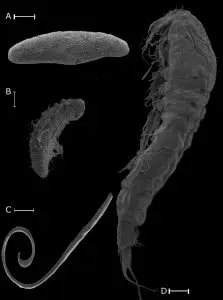 The Earth is not a solid mass of rock: its hot, dark, fractured subsurface is home to weird and wonderful life forms
The Earth is not a solid mass of rock: its hot, dark, fractured subsurface is home to weird and wonderful life forms
The living landscape all around us is just a thin veneer atop the vast, little-understood bulk of the Earth’s interior. A widespread misconception about the deep subsurface is that this realm consists of a continuous mass of uniform compressed solid rock. Few are aware that this mass of rock is heavily fractured, and water runs in many of these fractures and faults, down to depths of many kilometres. The deep Earth supports an entire biosphere, largely cut off from the surface world, and is still only beginning to be explored and understood.
The amount of water in the subsurface is considerable. Globally, the freshwater reservoir in the subsurface is estimated to be up to 100 times as great as all the available fresh water in the rivers, lakes and swamps combined. This water, ranging in ages from seven years to 2 billion years, is being intensely studied by researchers because it defines the location and scope of deep life. We know now that the deep terrestrial subsurface is home to one quintillion simple (prokaryotic) cells. That is two to 20 times as many cells as live in all the open ocean. By some estimates, the deep biosphere could contain up to one third of Earth’s entire biomass.
To comprehend the deep biosphere, we must look past the familiar rules of biology. On the surface, life without the Sun for an extended period of time is dangerous or deadly. Without daylight, no plants or crops can grow. Temperatures get colder and colder. Few organisms, including human beings, can long tolerate such conditions. For instance, people living within the Arctic Circle – as well as the maintenance staff at Antarctic research stations during winter – experience 24-hour darkness for several months each year. They are more vulnerable to health issues such as depression. They find ways to adapt and get through the long, dark, cold winter, but it isn’t easy.
Now imagine the challenges in places that have been isolated from sunlight and organic compounds derived from light-dependent reactions for millions or even billions of years. It seems incomprehensible that anything could survive there. Yet scientists, including the members of our team at Princeton University in New Jersey, have found surprisingly diverse microorganisms in the deep Earth, adapted to a lifestyle independent of the Sun.
Leave a Reply